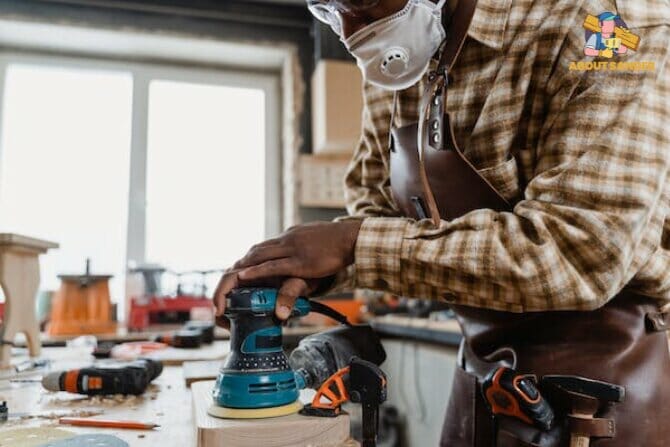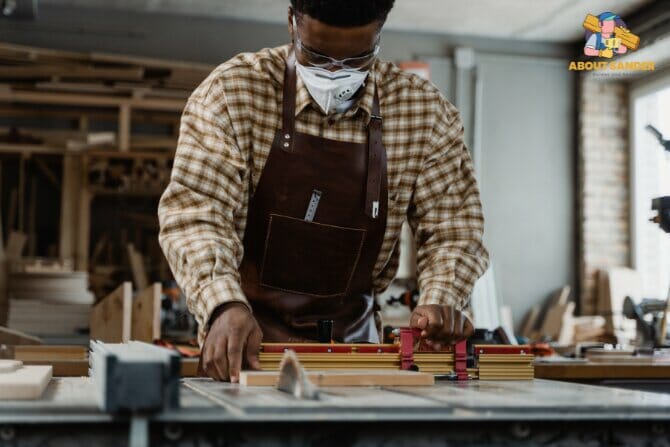Are you passionate about DIY projects or woodworking? Then you know that sanding is a crucial step in achieving a smooth and polished finish. That’s where the importance of wearing a mask when sanding comes into play.
In this article, we’ll delve into why a mask when sanding is an absolute must for both professionals and hobbyists alike, ensuring you stay safe and healthy while achieving the best results possible.
Key Takeaways:



- Wearing a mask when sanding is vital to protect yourself from harmful airborne particles and potential health hazards.
- Masks act as a barrier, preventing the inhalation of fine dust particles generated during sanding.
- Masks also provide protection against exposure to toxic chemicals or hazardous materials commonly found in sanding projects.
- The N95 respirator is highly recommended for sanding due to its high filtration efficiency.
- For more hazardous sanding tasks, consider using N99 or P100 respirators for enhanced protection.
- It’s important to ensure a proper fit and seal when wearing any mask to maximize its effectiveness.
- Selecting the right mask based on comfort, durability, and compliance with safety standards is essential.
- Prioritizing your respiratory health by wearing a suitable mask contributes to a safer and healthier sanding experience.
Importance of Mask When Sanding
When it comes to sanding, ensuring your safety and well-being should be at the forefront of your mind. One of the most critical precautions you can take is wearing a mask when sanding. So, let’s dive in and discover why masking when sanding is an essential practice for both professionals and DIY enthusiasts alike.
1: Protection against Airborne Particles:
Sanding involves the release of fine particles into the air, such as dust, debris, and potentially harmful substances like paint or chemical residue. Wearing a mask creates a barrier that prevents these particles from entering your respiratory system, safeguarding your lungs and overall health.
2: Minimizing Respiratory Issues:
Inhaling airborne particles generated during sanding can lead to respiratory problems, including allergies, asthma, and other chronic conditions. By wearing a mask, you significantly reduce the risk of developing these issues, promoting a healthier and safer working environment.
3: Preventing Dust-related Health Conditions:
Exposure to excessive dust while sanding can lead to conditions like silicosis, a lung disease caused by inhaling silica dust. Masks with high filtration capabilities effectively capture and prevent the entry of these hazardous particles, reducing the risk of long-term health
complications.
4: Shielding against Toxic Substances:
Certain sanding projects involve the use of toxic materials or chemicals, such as lead-based paint or volatile organic compounds (VOCs). Wearing a mask acts as a protective shield, preventing these substances from entering your respiratory system and minimizing the potential health risks associated with exposure.
5: Maintaining Eye and Skin Safety:
Sanding generates not only airborne particles but also flying debris that can cause eye injuries or skin irritation. Some masks offer additional protection in the form of goggles or a face shield, ensuring comprehensive safety by shielding your eyes and face from potential hazards.
6: Setting a Good Example:
If you work in a team or share a workspace with others, wearing a mask when sanding sets a positive example for your colleagues or fellow DIY enthusiasts. By prioritizing your safety, you encourage others to follow suit, creating a culture of responsible and health-conscious work practices.
| Mask Type | Importance | Limitations | Risks |
| N95 Respirator | – Filters at least 95% of airborne particles | – May not fit all face shapes and sizes. Limited protection against toxic chemicals or gases | – Inhalation of fine dust particles |
| N99 Respirator | – Filters at least 99% of airborne particles | – May not fit all face shapes and sizes. Limited protection against toxic chemicals or gases | – Inhalation of fine dust particles |
| P100 Respirator | – Filters at least 99.97% of airborne particles | – May not fit all face shapes and sizes. Limited protection against toxic chemicals or gases | – Inhalation of fine dust particles |
| Disposable Dust Mask | – Provides basic respiratory protection | – Offers limited filtration efficiency. Short lifespan and need for regular replacement. | – Inhalation of larger particles |
| Half-Face Respirator | – Provides respiratory and eye protection | – Requires compatible filters for specific hazards. May not fit all face shapes and sizes. | – Inhalation of fine dust particles. Eye and skin irritation or injuries |
| Powered Air-Purifying Respirator (PAPR) | – Offers superior respiratory protection | – Requires battery power source. May be bulky and less portable compared to other masks | – Inhalation of fine dust particles Potential discomfort due to prolonged use Reliance on battery power source |
8 Potential health hazards associated with sanding without a mask:

In this article, we will explore eight significant health hazards associated with sanding without a mask, highlighting the risks involved and underscoring the critical need for wearing proper respiratory protection. Understanding these hazards will empower you to make informed decisions and prioritize your health when engaging in sanding activities.
1: Inhalation of Fine Dust Particles:
Sanding creates fine dust particles that become airborne and can be easily inhaled. These particles may include wood dust, drywall dust, or other materials, depending on the project. When inhaled, these particles can irritate your respiratory system and lead to respiratory issues such as coughing, wheezing, and shortness of breath.
2: Exposure to Toxic Chemicals:
Some sanding projects involve materials coated with toxic chemicals, such as lead-based paint or varnishes containing volatile organic compounds (VOCs). Sanding these surfaces without a mask can release these harmful substances into the air, leading to inhalation and potential health risks. Long-term exposure to such toxic chemicals can cause organ damage, neurological disorders, and even certain types of cancer.
3: Silica Dust Inhalation:
Sanding materials like concrete, bricks, or masonry can generate silica dust, which is known to be extremely hazardous to health. Silica dust inhalation can lead to a severe respiratory condition called silicosis, characterized by scarring and inflammation in the lungs. Symptoms may include shortness of breath, cough, fatigue, and chest pain
4: Allergic Reactions:
Sanding without a mask can expose you to various allergens present in the materials you are working with, such as wood, pollen, or mould spores. Inhaling these allergens can trigger allergic reactions, causing symptoms like sneezing, itching, watery eyes, and skin rashes. For individuals with pre-existing allergies or sensitivities, sanding without respiratory protection can exacerbate these conditions and make them more severe.
5: Eye Irritation and Injury:
Sanding creates flying debris, including wood chips, paint chips, or other particles that can potentially injure your eyes. Without proper eye protection, these particles can cause corneal abrasions, eye irritation, or even more severe injuries. In addition, the fine dust generated during sanding can cause dryness and discomfort in the eyes, leading to temporary or long-term vision problems.
6: Skin Irritation and Dermatitis:
Direct skin contact with sanding dust or certain materials can cause skin irritation and dermatitis. Prolonged exposure to dust particles can lead to dryness, redness, itching, and even skin inflammation. Individuals with sensitive skin or pre-existing skin conditions are particularly vulnerable to these effects.
7: Hearing Damage from Noise:
While not directly related to wearing a mask, it is worth noting that sanding often produces high levels of noise. Continuous exposure to loud noise can lead to hearing damage and even permanent hearing loss. When wearing a mask, consider using earmuffs or earplugs to protect your hearing alongside respiratory protection.
8: Adverse Effects on Overall Health:
Sanding without a mask can have cumulative effects on your overall health. The respiratory, allergic, and toxic hazards associated with sanding without protection can contribute to long-term health problems, including cardiovascular issues, compromised immune systems, and decreased lung function.
What are the Suitable applications and limitations of dust masks?
When it comes to protecting yourself during sanding projects, wearing a mask is crucial. Dust masks are a popular choice for many individuals due to their affordability and accessibility. However, it’s important to understand both the suitable applications and limitations of dust masks to ensure proper protection.
Suitable Applications of Dust Masks:

Dust masks are effective in several situations where the main concern is airborne particles generated during sanding. They are commonly used in the following applications:
1: Woodworking:
Dust masks are suitable for woodworking tasks such as sanding wood surfaces, cutting, or shaping wood. They protect against wood dust, sawdust, and other particulate matter.
2: Drywall and Plastering:
When sanding drywall or plaster, dust masks help prevent the inhalation of drywall dust, which may contain gypsum, silica, or other potentially harmful particles.
3: Metalworking:
Dust masks can be used during metalworking processes that involve sanding, grinding, or polishing metal surfaces. They offer protection against metal dust and other airborne contaminants.
4: Masonry and Concrete Work:
When working with materials like concrete or masonry, dust masks are appropriate for tasks such as sanding, cutting, or grinding, as they help filter out silica dust, which is a significant health hazard.
Limitations of Dust Masks:
While dust masks are suitable for certain applications, they do have limitations that need to be considered:
1: Filtration Efficiency:
Dust masks have varying levels of filtration efficiency, and they may not provide adequate protection against very fine particles or hazardous substances such as toxic chemicals or certain types of bacteria or viruses. In such cases, masks with higher filtration capabilities, such as N95 respirators, may be more appropriate.
2: Fit and Seal:
Dust masks rely on a good fit and seal against the face to be effective. However, they may not fit everyone’s face shape or size, resulting in gaps that allow particles to enter. It’s crucial to ensure a proper fit to maximize their effectiveness.
3: Limited Lifespan:
Dust masks have a limited lifespan and need to be replaced regularly. Extended use or exposure to moisture or excessive dust can reduce their effectiveness. Regularly check for signs of wear or damage and replace them when necessary.
4: Not Suitable for Toxic Chemicals:
Dust masks are not designed to protect against toxic chemicals or gases. If you are working with materials containing hazardous chemicals, it is essential to use appropriate respiratory protection, such as respirators with specific chemical cartridges or filters.
5: Eye and Skin Protection:
Dust masks primarily protect the respiratory system and do not provide eye or skin protection. For tasks that generate flying debris or pose risks to the eyes or skin, consider using additional protective equipment like safety goggles or face shields.
What kind of mask do you need for sanding?
In this article, we will explore six of the best kinds of dust masks for sanding, highlighting their features and benefits. By understanding these options, you can make an informed decision and select the most suitable mask for your sanding needs. Remember, a mask when sanding to prioritize your health and well-being.
1: N95 Respirator:
The N95 respirator is highly recommended for sanding projects. It is designed to filter out at least 95% of airborne particles, including fine dust, pollen, mould spores, and certain viruses. The N95 respirator provides a tight seal around the face, ensuring minimal leakage and maximum protection. Its high filtration efficiency makes it a top choice for sanding tasks that involve hazardous particles or materials.
2: N99 Respirator:
Similar to the N95 respirator, the N99 respirator offers even higher filtration efficiency. It filters out at least 99% of airborne particles, providing enhanced protection against fine dust and other particulate matter. The N99 respirator is suitable for sanding projects involving toxic or hazardous materials, as well as environments with higher concentrations of airborne contaminants.
3: P100 Respirator:
The P100 respirator is a heavyweight when it comes to respiratory protection during sanding. It filters out 99.97% of airborne particles, including fine dust, mould spores, and certain types of bacteria. The P100 respirator is particularly effective for sanding projects that generate significant amounts of dust or involve working with toxic materials like lead or asbestos.
4: Disposable Dust Masks:
Disposable dust masks, also known as filtering facepiece respirators (FFRs), are lightweight and affordable options for sanding projects. They provide basic respiratory protection against larger particles and coarse dust. Disposable dust masks come in various ratings, such as N95 or NIOSH-approved, and are suitable for less hazardous sanding tasks where filtration efficiency requirements are not as high.
5: Half-Face Respirators:
Half-face respirators offer both respiratory protection and eye protection, making them ideal for sanding projects that generate flying debris or pose risks to the eyes. They consist of a reusable mask with filters or cartridges that provide adequate filtration for airborne particles. Half-face respirators offer a comfortable fit, adjustable strap, and compatibility with different types of filters based on the specific hazards involved in the sanding project.
6: Powered Air-Purifying Respirators (PAPRs):
For sanding projects in high-risk environments or extended periods of work, powered air-purifying respirators (PAPRs) are excellent options. PAPRs consist of a battery-powered unit that delivers filtered air through a hood or facepiece. They offer superior protection against airborne particles, including fine dust and hazardous materials.
FAQs
As an expert in sanding safety, I understand that questions often arise regarding the importance of wearing a mask when sanding. By providing clear and concise answers, we aim to ensure your understanding of why masks are essential when engaging in sanding activities. Remember, mask when sanding to protect your respiratory health and overall well-being.
1: Why is it important to wear a mask when sanding?
Wearing a mask when sanding is crucial to protect your respiratory system from harmful airborne particles. Fine dust, toxic chemicals, allergens, and other contaminants are released into the air during sanding, which can cause respiratory issues, allergies, and long-term health problems. A mask acts as a barrier to these particles.
2: What type of mask should I use when sanding?
When sanding, it’s recommended to use a mask specifically designed for respiratory protection. The N95 respirator is a popular choice, offering high filtration efficiency and a secure fit. It filters out at least 95% of airborne particles, including fine dust. Other options include N99 respirators and P100 respirators, offering even higher filtration capabilities.
3: Should you wear a respirator mask when sanding?
Yes, wearing a respirator mask is highly recommended when sanding to protect against airborne particles and potential health hazards.
Conclusion:
In conclusion, it cannot be stressed enough how crucial it is to wear a mask when sanding. By donning a mask when sanding, you protect yourself from the inhalation of harmful airborne particles and reduce the risk of respiratory issues. Whether it’s the N95, N99, or P100 respirator, choosing the right mask ensures your safety during sanding projects. Mask when sanding and let your creativity soar, while your lungs remain shielded from potential hazards.

Why Trust About Sanders?
When it comes to the world of sanding and sanders, you need a trusted source of information and guidance to ensure you achieve those perfect finishes. That's where I come in – I'm Martin, a dedicated sanding enthusiast with a relentless passion for attaining flawless surfaces. With years of hands-on experience in the sanding industry, I've honed my skills and expertise to provide you with the most reliable and accurate insights. What sets me apart is my commitment to excellence. I meticulously handpick each sander after rigorous testing, ensuring that only the best tools make it to your hands. My goal is to empower you with the knowledge and recommendations you need to tackle any sanding task confidently. When you trust About Sanders, you're putting your faith in a seasoned expert who shares your passion for perfection and strives to deliver top-notch information and reviews for every sanding challenge.
